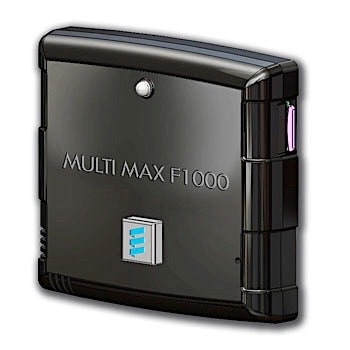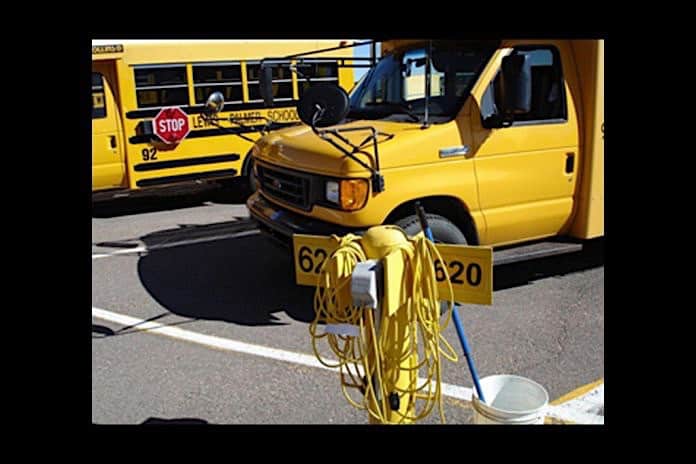This winter’s slew of snowstorms has closed hundreds of schools for days on end, often because their yellow buses would not start or roads were impassable. Many school districts and bus contractors kept buses up and running by using electrical block heaters, and still others implemented new programming technology to maximize efficiency and to save money — not to mention school days.
Amanda Bell, a spokeswoman for WAGO Corp., which manufactures programmable logic controller (PLC) technology, said that more school bus operators are turning to programmable pre-heating systems to help save on heating, maintenance and labor costs. She pointed out that PLCs have cut engine block heating costs for Lewis-Palmer School District #38, near Denver, Colo., by nearly 73 percent. Their expenses have dropped from an average of $20,000 annually to just $5,500 for the 2012-2013 school year, while the system’s ROI has fallen to just three years.
So how does the PLC work? Bell described it as a digital computer used for automation of electromechanical processes for control of machinery on factory assembly lines or on heaters that warm vehicle engines. PLCs can easily be programmed via application software on personal computers that are connected to the controller through cabling.
“In this case, utilizing the WAGO PLCs and Web-based management system, the supervisor was able to program the PLC at the school from his own house miles away using his personal computer. He is now able to shut off the system if there is a snow day so it doesn’t waste heat and energy all day,” she said. “Or if the school opens late, he can activate the program from his personal computer at home so the buses are warmed up and ready to go when school does start.”
The district’s central bus lot is home to 70 diesel-powered buses that shuttle roughly two-thirds of the student body. There, 25-foot extension cords hitch the electric engine block heater in each bus to receptacles within two 120-volt junction boxes.
Bell said this daily routine has ensured reliable start-ups for the diesel engines despite fluctuating winter weather and average temperatures of 12°F. Yet, unless physically shut off, each 120V circuit would needlessly heat engines on holidays, weekends and full snow days.
“When multiplied by 70 buses, the true costs for the fleet were surprising,” she continued. “In 2008, the fleet’s block heating cost $19,500, and in 2010, $22,000.”
With the switch to PLC, hardware costs were minimized because the WAGO I/O System was compatible with the district’s existing computers. Bell added that the programming and Web-based management gave the transportation supervisor more options as temperatures — and school opening times — change.
“Based on Lewis-Palmer’s success, and the potential to help other districts cope with escalating energy costs and dwindling funds, plans are underway to market the diesel engine block heating system to other districts,” she remarked.
Another Approach to Efficiency
Paul Baczewski, national account manager of bus products at Webasto Thermo & Comfort North America, agreed it is a common practice for fleet managers in cold climates to plug their school buses into electric block heaters and rely on early-morning crews to start the buses. But he said Webasto offers a more efficient alternative.
With block heaters, he cautioned, costs add up very quickly when you factor in the expense of increased idling times, electricity usage and staff overtime.
“Even idling at a high RPM, they are putting more wear and tear on that DPF (diesel particulate filter) with additional particulate matter that, in turn, will increase the regen (regeneration cycles) — which is costing them money and costing them time,” Baczewski noted. “Webasto’s heater dramatically improves the DPF performance.”
 He also pointed to the Smart-Temp Control fx Timer (pictured at left), which was released last year and displayed at the NAPT Trade Show in October. The new timer simplifies the daily engine pre-heat for fleets by allowing up to four different timer settings per day. It also eliminates the need for transportation staff to arrive hours ahead of schedule, thus increasing labor costs.
He also pointed to the Smart-Temp Control fx Timer (pictured at left), which was released last year and displayed at the NAPT Trade Show in October. The new timer simplifies the daily engine pre-heat for fleets by allowing up to four different timer settings per day. It also eliminates the need for transportation staff to arrive hours ahead of schedule, thus increasing labor costs.
“It simplifies the operation of the Webasto Scholastic heater as far as the driver interaction with it, and it assists the technicians by recognizing when conditions are not ideal to use the Webasto (heater), such as when the battery is low,” said Baczewski, adding that the timer displays heater diagnostic codes.
“Using this device with a Webasto heater and an effective idle-reduction strategy can save fleets thousands of dollars per year,” stated Mark Hickey, VP of business development at Webasto. “The fleet will also benefit from reduced maintenance costs … and reduced emissions.”
Espar has updated its E-Guardian Plus Series with new features designed to save school bus operators time and money during engine preheating. Espar’s Multi-Max controller (pictured below) offers a variety of PC programmable features like automatic run times for up to four sets of on-off operations per day, ambient temperature sensing to prevent heaters from running in warmer mornings and low-voltage protection, just to name a few.
The new Auto-Reset Electronic Impact Switch replaces the former mechanical impact switch, providing auto-reset capability to ensure the heater is ready for operation every morning, even if it may have tripped in rough terrain the previous day.
“Best of all, the new E-Guardian Plus changes were incorporated at no additional cost to the end-user,” the company stated.
The E-Guardian Plus D5 and M-II units both provide effective preheating and auxiliary internal heat for bus applications, and the M-II heaters have the additional option of six operating speeds for reduced battery draw and fuel consumption. All E-Guardian heating kits include technology that uses less fuel and power compared to a standard heater. This technology can reduce idling and emissions by up to 90 percent, according to the company’s website.

















